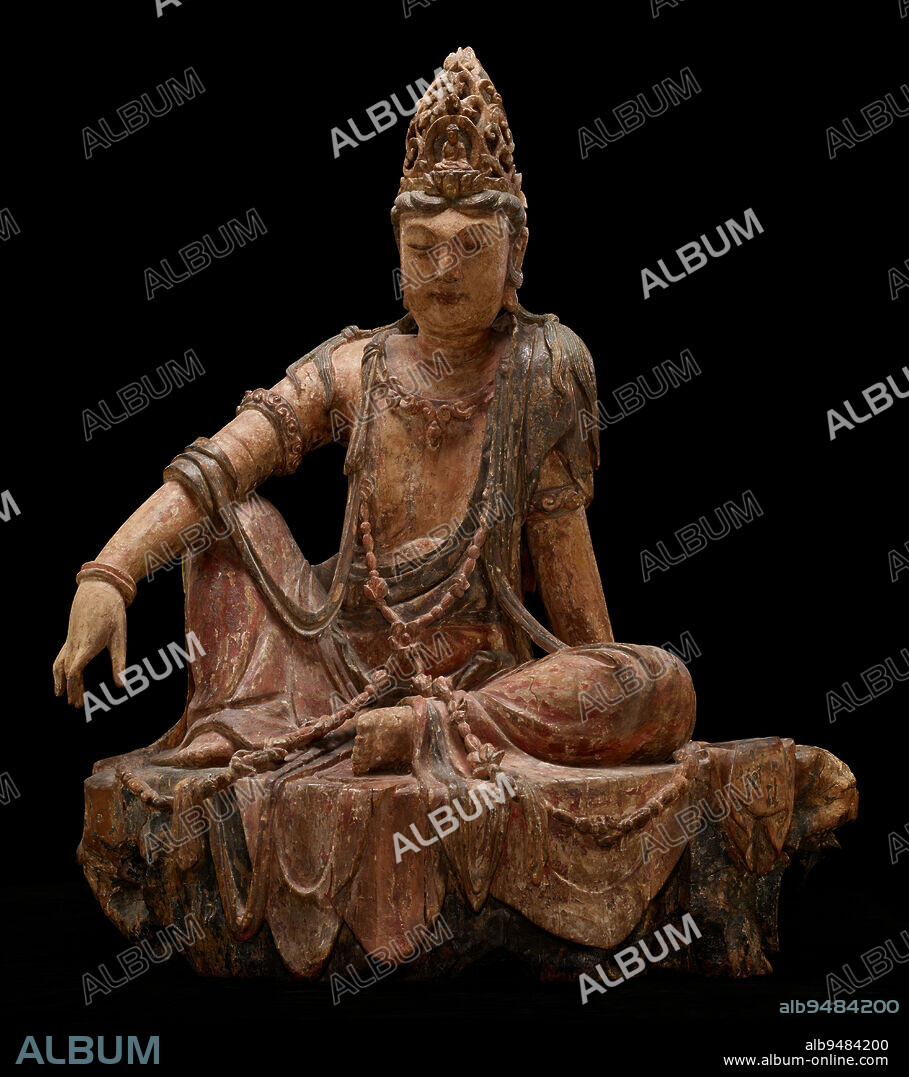alb9484200
Avalokiteshvara Bodhisattva in the Water-Moon Form (Shuiyue Guanyin), 12th century, 40 1/2 x 33 1/2 x 20in. (102.9 x 85.1 x 50.8cm), Wood, gesso and pigments, China, 12th century, Of the many manifestations of the bodhisattva Avalokiteshvara, perhaps none was more prevalent in East Asia than the uniquely Chinese form known as 'Water-Moon Avalokiteshvara,' which later also spread to Korea and Japan. This form of the bodhisattva presides over his own paradise, Potolaka, which is described in scripture as a rugged seaside cave from which Avalokiteshvara could admire the reflection of the moon in the water. Appropriately, he appears meditative and relaxed and is seated informally in the 'royal-ease' posture. Ornately dressed, with silk robes, fluttering sashes, jewelry, and an elaborate hairstyle, he also wears a headpiece that features an image of Amitbha, the buddha to whom Avalokiteshvara attends. Believers might look to a sculpture like this as a guide for their own journeys toward enlightenment.

|
Add to another lightbox |
|
Add to another lightbox |



Buy this image.
Select the use:

Caption:
Avalokiteshvara Bodhisattva in the Water-Moon Form (Shuiyue Guanyin), 12th century, 40 1/2 x 33 1/2 x 20in. (102.9 x 85.1 x 50.8cm), Wood, gesso and pigments, China, 12th century, Of the many manifestations of the bodhisattva Avalokiteshvara, perhaps none was more prevalent in East Asia than the uniquely Chinese form known as 'Water-Moon Avalokiteshvara,' which later also spread to Korea and Japan. This form of the bodhisattva presides over his own paradise, Potolaka, which is described in scripture as a rugged seaside cave from which Avalokiteshvara could admire the reflection of the moon in the water. Appropriately, he appears meditative and relaxed and is seated informally in the 'royal-ease' posture. Ornately dressed, with silk robes, fluttering sashes, jewelry, and an elaborate hairstyle, he also wears a headpiece that features an image of Amitbha, the buddha to whom Avalokiteshvara attends. Believers might look to a sculpture like this as a guide for their own journeys toward enlightenment.
Credit:
Album / quintlox
Releases:
Model: No - Property: No
Rights questions?
Rights questions?
Image size:
5102 x 5749 px | 83.9 MB
Print size:
43.2 x 48.7 cm | 17.0 x 19.2 in (300 dpi)
Keywords:
12 CENTURY • 12TH CENTURY • 12TH • ADMIRE • AMITBHA • APPROPRIATELY • AVALOKITESHVARA BODHISATTVA • AVALOKITESHVARA • BELIEVERS MIGHT LOOK • BODHISATTVA AVALOKITESHVARA • BODHISATTVA PRESIDES • BONNET • BUDDHA • CHARACTERISTIC • CHINA • CHINE • CHINESE • CONTEMPLATIVE • DESCRIBED • EAST ASIA • ELABORATE HAIRSTYLE • ENLIGHTENMENT • FEATURES • FLUTTERING SASHES • FORM • GESSO • GUIDÉ • HAT • HATS • HEAD COVERING • HEADDRESS • HEADGEAR • HEADPIECE • IMAGE • JAPAN • JAPANESE • JEWELRY • KOREA • LATER • LUNA • MANIFESTATIONS • MEDITATIVE • MOON • ORNATELY DRESSED • OWN JOURNEYS • OWN PARADISE • PEACEFUL • PERHAPS NONE • PIGMENTS • PORCELAIN • POTOLAKA • PREVALENT • REFLECTION • RELAXED • ROYAL-EASE' POSTURE • RUGGED SEASIDE CAVE • SCRIPTURE • SCULPTED • SCULPTING • SCULPTURE • SCULPTURE. • SEATED INFORMALLY • SHUIYUE GUANYIN • SILK ROBES • SPREAD • TRANQUIL • UNIQUELY CHINESE FORM • WATER • WATER-MOON AVALOKITESHVARA • WATER-MOON FORM • WEARS • WHOM AVALOKITESHVARA ATTENDS • WOOD • XII CENTURY
 Pinterest
Pinterest Twitter
Twitter Facebook
Facebook Copy link
Copy link Email
Email
